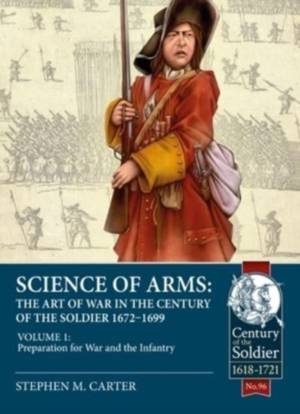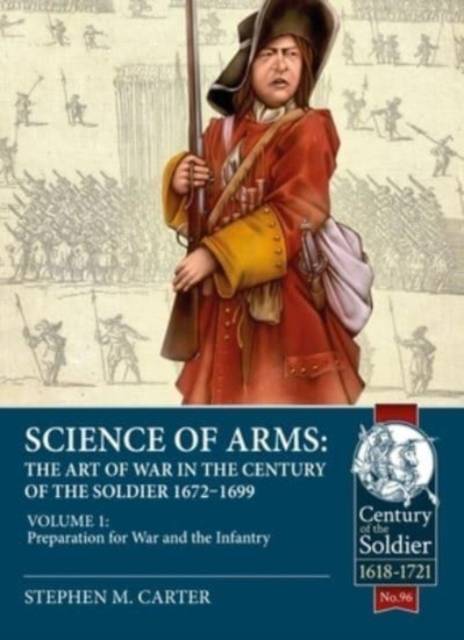
- Afhalen na 1 uur in een winkel met voorraad
- Gratis thuislevering in België vanaf € 30
- Ruim aanbod met 7 miljoen producten
- Afhalen na 1 uur in een winkel met voorraad
- Gratis thuislevering in België vanaf € 30
- Ruim aanbod met 7 miljoen producten
Zoeken
Science of Arms: The Art of War in the Century of the Soldier 1672 - 1699
Volume 1 - Preparation for War and the Infantry
Stephen M Carter
€ 41,95
+ 83 punten
Uitvoering
Omschrijving
In the late 17th century war was one of the most important of all the human professions. It was for this reason that the greatest generals labored to acquire every ounce of knowledge, and from this went on to perfect the military art. These men judged that nothing was so necessary for the salvation of their states as the science of arms. They saw that it was by this means that nations repelled public and private insults. It was through the application of war, that citizens defended the liberty of their country and maintained discipline within their own territories. As a result, these men became professionals, and in so doing aroused the virtue of their fellow-citizens and ensured the happiness of their people. These words are not new but adapted from the opening chapter of the Tracte de la Guerre ou Politique Militaire published in 1677. By then, the French Army had reached the peak of military perfection and Science of Arms draws on this expertise to create the definitive manual on the art of war, split across three volumes.
The first volume of the Science of Arms introduces the 17th century concept of the just war. Explains the duties of the general and his staff. Details the Ordinance Park, plus the weapons and equipment needed to wage war. This is followed by the evolutions, drills, postures, and tactics of the infantry from the lowest private to the colonel. The second volume covers the disciplines of the cavalry and the artillery, fighting a campaign and winning in battle. The final volume tackles the construction, defense, and the attack of fortifications in the age of Vauban.
For the first time the historian, writer, reenactor, or military enthusiast can fully comprehend the spontaneous actions of the greatest generals. Science of Arms fills in the gaps found in eyewitness accounts, clarifies the unconscious behavior of the officers, and brings to life the battle plans. This outstanding work combines all the great military treatise of the 17th century, with the original illustrations to form a unique depiction of the art of war as learnt by all the officers, and generals of the age. Science of Arms is everything needed to fully understand the military art as practiced in the century of the soldier.
The first volume of the Science of Arms introduces the 17th century concept of the just war. Explains the duties of the general and his staff. Details the Ordinance Park, plus the weapons and equipment needed to wage war. This is followed by the evolutions, drills, postures, and tactics of the infantry from the lowest private to the colonel. The second volume covers the disciplines of the cavalry and the artillery, fighting a campaign and winning in battle. The final volume tackles the construction, defense, and the attack of fortifications in the age of Vauban.
For the first time the historian, writer, reenactor, or military enthusiast can fully comprehend the spontaneous actions of the greatest generals. Science of Arms fills in the gaps found in eyewitness accounts, clarifies the unconscious behavior of the officers, and brings to life the battle plans. This outstanding work combines all the great military treatise of the 17th century, with the original illustrations to form a unique depiction of the art of war as learnt by all the officers, and generals of the age. Science of Arms is everything needed to fully understand the military art as practiced in the century of the soldier.
Specificaties
Betrokkenen
- Auteur(s):
- Uitgeverij:
Inhoud
- Aantal bladzijden:
- 334
- Taal:
- Engels
- Reeks:
Eigenschappen
- Productcode (EAN):
- 9781804510025
- Verschijningsdatum:
- 16/01/2023
- Uitvoering:
- Paperback
- Formaat:
- Trade paperback (VS)
- Afmetingen:
- 185 mm x 244 mm
- Gewicht:
- 816 g

Alleen bij Standaard Boekhandel
+ 83 punten op je klantenkaart van Standaard Boekhandel
Beoordelingen
We publiceren alleen reviews die voldoen aan de voorwaarden voor reviews. Bekijk onze voorwaarden voor reviews.











